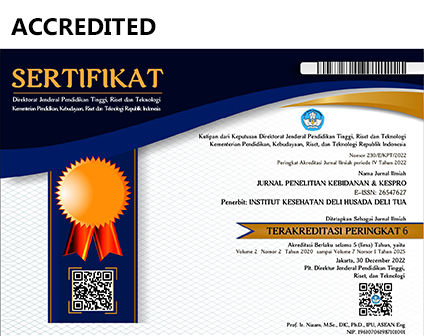THE EFFECT OF SOY MILK GIVING TO INCREASE BREAST MILK PRODUCTION IN PUBLIC MOTHERS
Abstract
Low milk production is a major problem for new mothers, apart from drowning or flat nipples, swollen breasts, babies who are reluctant to breastfeed because of improper technique or babies with short tongues. The purpose of this study was to determine the effect of giving soy milk on increasing breast milk production in post-partum mothers at the Pratama Sehati Husada clinic, Blu-Biru District, Deli Serdang Regency in 2020. This study used a quasi experimental method with a One Group Pretest-Postest design. Sampling was done by total sampling method. The respondents used are postpartum mothers. The bivariate analysis used in this study was the nonparametric difference test with the Wilcoxon test. The results of statistical tests give a p value of 0.000 smaller than 0.05 (0.655 <0.05), so it can be concluded that Ha is accepted and Ho is rejected, which means that there is an effect of giving soy milk on increased milk production in postpartum mothers. His suggestions can add insight and knowledge for researchers about Soymilk Feeding on Increasing Breast Milk Production in Postpartum Mothers. And for mothers and families who already know how to consume soy milk and its benefits can be disseminated in society to support government programs to promote the reduction of breastfeeding that is not smooth. As well as providing knowledge to the community about the application of consuming soy milk in overcoming unsanitary milk production in postpartum mothers, so as to help postpartum mothers to facilitate the smooth production of breast milk.
References
Dewi, Vivian, Nanny, Lia. 2015. Asuhan Kebidanan pada Ibu Nifas. Jakarta: Salemba
Direktorat Jenderal Bina Kesehatan Masyarakat, Pedoman penyelenggaraan pelatihan konseling menyusui dan pelatihan fasilitator konseling menyusui. 2014. Jakarta: Departemen Kesehatan.
Haryono R, Setianingsih, S. 2015. Manfaat Asi Eksklusif Untuk Buah Hati Anda. Yogyakarta: Gosyen Publising.
Irwan A.W. 2015. Budidaya Tanaman Kedelai (Glycine max (L.) Merill). Jurusan Budidaya Pertanian. Fakultas Pertanian. Universitas Padjadjaran. Jatinangor. Bandung.
Kementerian Kesehatan RI. 2014. Profil Kesehatan Indonesia Tahun 2014. Jakarta: Kemenkes RI.
Keputusan Menteri Kesehatan Republik Indonesia Nomor 450/ MENKES/ SK/ IV/ 2014 tentang Pemberian ASI Eksklusif pada Bayi Indonesia. Available from: URL HIPERLINK. www.gizi.depkes.go.id/ download/ pekanasi-2014 (13 Mei 2014).
Medeiros M. F. D., Rocha S. C. S., Alsina O. L. S., Jerönimo C. E. M., Medeiros U. K. L., da Mata A. L. M. L. (2016). Drying of Pulps of Tropical Fruits in Spouted Bed: Effect of Composition on Dryer Performance. Journal of Drying Technology. Volume 20, Issue 4 & 5 , 855 – 881.
Mudjajanto, E.S. & F.R. Kusuma. 2015. Susu Kedelai, Susu Nabati yang Menyehatkan. Agromedia Pustaka. Jakarta.
Notoatmodjo. 2015. Metodologi Penelitian Kesehatan. Jakarta : Rineka Cipta.
Prasetyono D.S, 2015. ASI Eksklusif, Pengenalan, Praktik, Kemanfaatan kemanfaatannya. Yogyakarta: Diva Press.
Prasetyono S,D. 2015. Buku Pintar ASI Eksklusif. Jogjakarta: Diva Press (Anggota IKAPI).
Susilorini, Tri Eko dan Manik E. S. 2016. Produk Olahan Susu. Penerbit Penebar Swadaya. Malang.
Syherni, dkk. 2017. Perawatan Masa Nifas. Yogyakarta : Fitramaya
The American Journal of Clinical Nutrition, 84 ; 406-413. http://ajcn.nutrition.org
WHO. 2014. Global Strategy for Infant and Young Child Feeding. Avaible from www.who.int/nutrition/topics/gl obal_strategy/en/
Widjaya. 2015. Undang-Undang Tenaga Kesehatan. Surabaya: Karina








